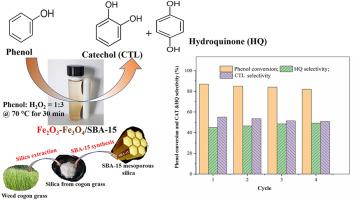利用草炭硅合成的介孔 SBA-15 上支撑的铁赤铁矿-磁铁矿复合材料作为苯酚羟基化过程中的固体催化剂
IF 4.3
3区 材料科学
Q2 MATERIALS SCIENCE, MULTIDISCIPLINARY
引用次数: 0
摘要
苯酚羟基化是指使用过氧化氢(H2O2)氧化苯酚(C6H5OH),生成苯二酚(C6H4(OH)2),主要是儿茶酚(CTL)和对苯二酚(HQ)。这些产品在制药行业需求量很大。因此,进一步改进异相铁催化剂仍然值得研究。在此,本研究将重点放在一种赤铁矿(Fe2O3)-磁铁矿(Fe3O4)复合催化剂上,该催化剂以 SBA-15 为载体,并使用了从高根草中提取的二氧化硅来进行苯酚羟基化反应。提取的二氧化硅呈白色粉末状,无定形结构,可用作合成 SBA-15 的二氧化硅源。催化剂制备完成后,利用 X 射线吸收近边结构(XANES)证实了 SBA-15 上存在 Fe2O3、Fe3O4 和 Fe2O3-Fe3O4 复合材料。X 射线光电子能谱(XPS)分析有助于深入了解催化剂的表面,发现 Fe2O3-Fe3O4/SBA-15 的铁物种分散度最高。在催化性能方面,与单独的 Fe3O4/SBA-15 或 Fe2O3/SBA-15 相比,Fe2O3-Fe3O4/SBA-15 的转化率最高,达到 88%,HQ 选择性为 46%。磁分离方法表明,含有 Fe3O4 的催化剂很容易分离。可重复使用性研究表明,Fe2O3-Fe3O4/SBA-15 的活性可保持到第 4 个循环,这表明与 Fe3O4/SBA-15 相比,铁的沥滤作用最小。总之,本研究为苯酚羟化和铁基催化剂的催化性能提供了见解,强调了 Fe2O3-Fe3O4/SBA-15 作为一种有效且可重复使用的催化剂的潜力。本文章由计算机程序翻译,如有差异,请以英文原文为准。

Iron hematite-magnetite composite supported on mesoporous SBA-15 synthesized by using silica from cogon grass as a solid catalyst in phenol hydroxylation
Phenol hydroxylation involves the oxidation of phenol (C6H5OH) using hydrogen peroxide (H2O2) to yield benzenediol (C6H4(OH)2), mainly catechol (CTL) and hydroquinone (HQ). These products are in high demand in the pharmaceuticals industry sector. Thus, it is still worth investigating for further improvement in terms of heterogeneous iron catalysts. Herein, this research focuses on an iron hematite (Fe2O3)-magnetite (Fe3O4) composite catalyst supported on SBA-15 using silica from cogon grass for phenol hydroxylation. The extracted silica exhibited a fine white powder appearance and an amorphous structure, used as a silica source for SBA-15 synthesis. After catalyst preparation, the presence of Fe2O3, Fe3O4, and Fe2O3–Fe3O4 composite on SBA-15 was confirmed by using X-ray absorption near-edge structure (XANES). X-ray photoelectron spectroscopy (XPS) analysis provided insights into the surface of the catalyst, revealing that Fe2O3–Fe3O4/SBA-15 had the highest dispersion of iron species. In terms of catalytic performance, Fe2O3–Fe3O4/SBA-15 displayed the highest conversion of 88 % and HQ selectivity of 46 % compared with lone Fe3O4/SBA-15 or Fe2O3/SBA-15. The magnetic separation approach demonstrated the easy separation of catalysts containing Fe3O4. Reusability studies showed that Fe2O3–Fe3O4/SBA-15 maintained its activity up to the 4th cycle, suggesting minimized iron leaching compared to Fe3O4/SBA-15. Overall, this study provides insights into the catalytic performance of phenol hydroxylation and iron-based catalysts, emphasizing the potential of Fe2O3–Fe3O4/SBA-15 as an effective and reusable catalyst.
求助全文
通过发布文献求助,成功后即可免费获取论文全文。
去求助
来源期刊

Materials Chemistry and Physics
工程技术-材料科学:综合
CiteScore
8.70
自引率
4.30%
发文量
1515
审稿时长
69 days
期刊介绍:
Materials Chemistry and Physics is devoted to short communications, full-length research papers and feature articles on interrelationships among structure, properties, processing and performance of materials. The Editors welcome manuscripts on thin films, surface and interface science, materials degradation and reliability, metallurgy, semiconductors and optoelectronic materials, fine ceramics, magnetics, superconductors, specialty polymers, nano-materials and composite materials.
 求助内容:
求助内容: 应助结果提醒方式:
应助结果提醒方式:


